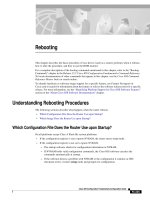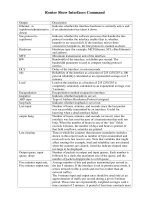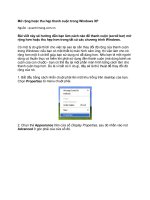Tài liệu mở rộng quản trị mạng Router show interfaces command
Bạn đang xem bản rút gọn của tài liệu. Xem và tải ngay bản đầy đủ của tài liệu tại đây (12.38 KB, 3 trang )
Router Show Interfaces Command
Output Description
Ethernet...is
(up/down/administrative
down)
Indicates whether the interface hardware is currently active and
if an administrator has taken it down.
line protocol is
(up/down)
Indicates whether the software processes that handle the line
protocol consider the interface usable (that is, whether
keepalives are successful). If the interface misses three
consecutive keepalives, the line protocol is marked as down.
Hardware Hardware type (for example, MCI Ethernet, SCI, cBus Ethernet)
and address.
MTU Maximum transmission unit of the interface.
BW Bandwidth of the interface, in kilobits per second. The
bandwidth parameter is used to compute routing protocol
metrics.
DLY Delay of the interface, in microseconds.
rely Reliability of the interface as a fraction of 255 (255/255 is 100
percent reliability) calculated as an exponential average over 5
minutes.
Load Load on the interface as a fraction of 255 (255/255 is
completely saturated), calculated as an exponential average over
5 minutes.
Encapsulation Encapsulation method assigned to interface.
keepalive Indicates whether keepalives are set.
ARP type: Type of Address Resolution Protocol assigned.
loop back Indicates whether loopback is set or not.
Last input Number of hours, minutes, and seconds since the last packet
was successfully transmitted by an interface. Useful for
knowing when a dead interface failed.
output hang Number of hours, minutes, and seconds (or never) since the
interface was last reset because of a transmission that took too
long. When the number of hours in any of the “last” fields
exceeds 24 hours, the number of days and hours is printed. If
that field overflows, asterisks are printed.
Last clearing Time at which the counters that measure cumulative statistics
shown in this report (such as number of bytes transmitted and
received) were last reset to zero. Note that variables that might
affect routing (for example, load and reliability) are not cleared
when the counters are cleared. Asterisks indicate elapsed time
too large to be displayed.
Output queue, input
queue, drops
Number of packets in output and input queues. Each number is
followed by a slash, the maximum size of the queue, and the
number of packets dropped due to a full queue.
Five minutes input rate,
Five minutes output rate
Average number of bits and packets transmitted per second in
the last 5 minutes. If the interface is not in promiscuous mode, it
senses network traffic it sends and receives (rather than all
network traffic).
The 5-minute input and output rates should be used only as an
approximation of traffic per second during a given 5-minute
period. These rates are exponentially weighted averages with a
time constant of 5 minutes. A period of four time constants must
pass before the average will be within 2% of the instantaneous
rate of a uniform stream of traffic over that period.
packets input Total number of error-free packets received by the systems.
bytes input Total number of bytes, including data and MAC encapsulation,
in the error-free packets received by the systems.
no buffers Number of received packets discarded because there was no
buffer space in the main system. Compare with “ignored” count.
Broadcast storms on Ethernet are often responsible for no input
buffer events.
Received...broadcasts Total number of broadcast or multicast packets received by the
interface. The number of broadcasts should be kept as low as
practicable. An approximate threshold is less than 20% of the
total number of input packets.
runts Number of packets that are discarded because they are smaller
than the medium’s minimum packet size. Any Ethernet packet
that is less than 64 bytes is considered a runt. Runts are usually
caused by collisions. More than one runt pr million bytes
received should be investigated.
giant Number of packets that are discarded because they exceed the
medium’s maximum packet size. Any Ethernet packet that is
greater than 1518 bytes is considered a giant.
input error Includes runts, giant, no buffer, CRC, frame, overrun, and
ignored counts. Other input-related errors can also cause the
input error to be increased, and some datagrams may have more
than one error; therefore, this sum may not balance with the sum
of enumerated input error count.
CRC Cyclic redundancy checksum generated by the originating LAN
station or far-end device does not match the checksum
calculated from the data received. On a LAN, this usually
indicates noise or transmission problems on the LAN interface
bus itself. A high number of CRCs is usually the result of
collisions or a station transmitting bad data.
frame Number of packets received incorrectly having a CRC error and
a noninteger number of octets. On a LAN, this is usually the
result of collision or a malfunctioning Ethernet device.
overrun Number of times the receiver hardware was unable to hand
received data to a hardware buffer because the input rate
exceeded the receiver’s ability to handle the data.
ignored Number of received packets ignored by the interface because
the interface hardware ran low on internal buffers mentioned
previously in the buffer description. Broadcast storms and bursts
of noise can cause the ignored count to be increased.
input packets with
dribble condition
detected
Dribble bit error indicates that a frame is slightly too long. This
frame error counter is incremented just for informational
purposes; the router accepts the frame.
packets output Total number of messages transmitted by the system.
bytes Total number of bytes, including data and MAC encapsulation,
transmitted by the system.
underruns Number of times that the transmitter has been running faster that
the router can handle. This may never be reported on some
interfaces.
output errors Sum of all errors that prevented the final transmission of
datagrams out of the interface being examined. Note that this
may not balance with the sum of the enumerated output errors,
as some datagrams may have more than one error, and others
may have error that do not fall into any of the specifically
tabulated categories.
collisions Number of messages retransmitted due to an Ethernet collision.
This is usually the result of an overextended LAN (Ethernet or
transceiver cable too long, more than two repeaters between
stations, or too many cascaded multiport transceiver). A packet
that collides is counted only once in output packets.
Interface resets Number of times an interface has been completely reset. This
can happen of packets queued for transmission were not sent
within several seconds. On a serial line, this can be caused by a
malfunctioning modem that is not supplying the transmit clock
signal, or by a cable problem. If the system notices that the
carrier detect line of a serial interface is up, but the line protocol
is down, it periodically resets the interface in an effort to restart
it. Interface resets can also occur when an interface is looped
back of shut down.









